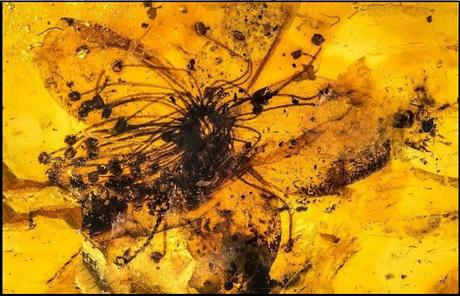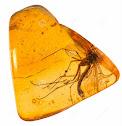Amber is very old. The oldest specimens so far identified date back 320 million years to the era of Palaeozoic tree-ferns. More modern ambers were formed during the Mesozoic period between 66 and 250 million years ago in the populations of cedars, redwoods and ancient pines that covered much of the earth. Interestingly the largest deposits of amber are to be found around the Baltic basin.
A plant's resin, part of its self-defence mechanism, was a polymer made up of terpenes (hydrocarbon rings). It would weep out at the place where the plant had suffered damage - for instance a gouge in bark or stem, a snapped off branch or an insect borehole - and it acted like a sticky liquid bandage to seal the wound and prevent invasion by bacteria or other harmful organisms.
This resin hardened over time and although it was organic, it did not decompose as most organic material does. It was not water-soluble, and with a melting point of 200-400 C, it was a relatively stable material, and durable enough to have lasted millions of years.
What makes amber particularly attractive to us is its glass-like transparency, its colouration (anything from milky white through honey gold to blue and deep black) and a tendency to contain 'inclusions', insects, seeds, pollens, sometimes whole blossoms (see below) that became entombed in the seeping resin and were subsequently 'fossilized'... "a honeyed window to a long-forgotten past" as a fellow blogger so eloquently put it.

dogrose blossom preserved in amber
Ants, flies and mosquitos are by far the commonest fossils found in amber. Unsurprisingly, the larger the inclusion, the more valuable the piece will be. Whole flowers are very rare. Small frogs, lizards and scorpions are ever rarer. They were probably asleep at the time of their entombing. And this is the place to debunk a myth that has gained credence ever since the first 'Jurassic Park' movie, that extinct creatures can be re-engineered from DNA found in amber. That remains fantasy. (Sound of heavy footsteps approaching.)By the way my chosen title for this Saturday's blog spins on that of a 1944 historical novel 'Forever Amber ' by Kathleen Winsor, which charts the progress of one Amber St Clare as she makes her way up through the ranks of 17th century English society by sleeping with or marrying successively richer and more important men while her heart remains true to the one she can never have. I've not read the novel. It was curiosity to see how it might relate to the weekly theme that drew me. The synopsis proved a catalyst for this latest from the imaginarium.

dogroses with amber eyes
Fossil EyesIf not the sun for love, a constellationof some recently discovered dimmer starsmust serve this ruthless dogrose ramblingout of Erewhon towards Empyrean.Amber is her name, her yielding is softand blushes fair, though in secret shame, as she makes steps of men's affections, slaves of their pierced souls in her climb.
In turn they ring her, think they have her,but not for nothing does the lady wearamber dangling over her occluded heart. She doesn't give a fig, despises the fools,
this pretty scheming bloom, Behind her honeyed flecks lie the hardest fossil eyes,and such secret suffering as wound sealedwithin remains mute as a scorpion's sting.

Thanks for reading, S ;-) Email ThisBlogThis!Share to TwitterShare to Facebook
